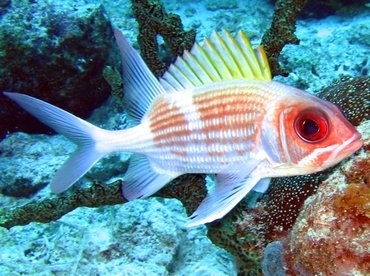
Holocentrus ascensionis
FAMILY
Holocentridae
TAXONOMY
Holocentrus ascensionis Osbeck, 1765, Acension Island.
OTHER COMMON NAMES
English: Common squirrelfish, longjaw squirrelfish, French:
Marignan coq; Spanish: Candil gallito.
PHYSICAL CHARACTERISTICS
A reddish, sometimes blotched, fish with a large dark eye.
Typically grows to about 12 in (30.5 cm), although reports exist
of specimens twice that size. Has a double dorsal fin, with
the front fin comprising sharp spines and taking a yellowish
hue. The back fin is much taller, with flexible rays.
DISTRIBUTION
Gulf of Mexico and the western Atlantic Ocean from New
York to Brazil, and east to Bermuda. Eastern Atlantic in
Gabon, Angola, St. Paul’s Rocks, St. Helena, and Ascensiуn Island.
HABITAT
Subtropical reefs with suitable structures for hiding during the
day. Commonly seen by divers in very shallow waters, but also
found at depths down to 590 ft (180 m).
BEHAVIOR
Remains hidden from view during the day, either in deeper
waters or in shallow-water crevices. May occur alone or in aggregations
of up to a few dozen fish. This species makes grunting
and clicking noises.
FEEDING ECOLOGY AND DIET
Mainly nocturnal feeders, consuming crustaceans and other
invertebrates. Predators include sea birds and other fishes,
such as the common dolphinfish (Corphaena hippurus), mutton
snapper (Lutjanus analis), and yellowfin tuna (Thunnus
albacares).
REPRODUCTIVE BIOLOGY
Mating
BEHAVIOR
includes a pairing of male and female,
during which they bring their tails together while their
heads face away from one another. The eggs are pelagic.
The larvae often venture far out to sea, and return to the
reefs as adults.
CONSERVATION STATUS
Not listed by the IUCN.
SIGNIFICANCE TO HUMANS
Enjoyed by divers in their natural
HABITAT
, squirrelfishes are
also part of the aquarium trade.
Other popular Animals
Photo Gallery of - Squirrelfish





 Animalia Life
Animalia Life